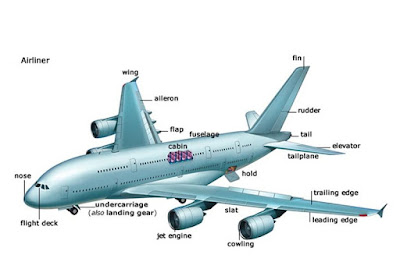The basic secondary controls are flaps,slats,spoilers and trim tabs. They are used to changed the lift and drag characteristics of the aircraft or in some aircraft to assist the primary flight controls.
Wing Flaps and Slats (High Lift Devices): the wing are hinged or sliding airfoil which increases the wing area,chamber and down wash. Flaps are located near the trailing edge on the both sides of the wing.
On the large transport category airplane that need large amount of lift multiple slotted flaps are used in conjunction with leading edge slats and flaps. the slats are added on the both sides of the leading edge. The slats further increase the chamber and also helps to operate the wing at much higher angle of attack by further improving the airflow condition.
The slats when extended from a slot,air flows through the slot and over the main wing,smoothing out the airflow over the wing and delaying the onset of the stall.
This increases in the lift produced by the wing will also decrease the stall speed. This will reduce the take-off,landing speeds and improve maneuvering capability at low speed during take-off and landing. How much flaps should be used during takeoff and landing depends upon aircraft weight,runway length,temperatures etc.
Types of trailing edge flaps:
The slats when extended from a slot,air flows through the slot and over the main wing,smoothing out the airflow over the wing and delaying the onset of the stall.
This increases in the lift produced by the wing will also decrease the stall speed. This will reduce the take-off,landing speeds and improve maneuvering capability at low speed during take-off and landing. How much flaps should be used during takeoff and landing depends upon aircraft weight,runway length,temperatures etc.
Types of trailing edge flaps:
Spoilers: The Spoilers are small rectangular metal deflectors hinged on the upper surface of the wing. they are normally flushed along the smooth upper chamber of the wing. On the large transport category aircraft,they are also raised to augment the roll during turn or as the ground spoilers immediately after landing. If required they are raised in the air as flight spoilers(speed break) to reduce the speed quickly and or increase the rate of descend.
Trim Tab: The trim tab is small movable secondary control surface hinged to primary control surfaces. The trim tab is moved in the direction opposite that of the primary control surfaces. The trim tabs can be positioned by mechanical or electrical means by the pilot to correct any out of balance effect.
The trim tab relieves the pilot for continuous application of the force on the primary controls. In the big jet airplane,elevators trim tab is eliminated by the movable stabilizer. Types of tabs are
- Trim Tab
- Balance Tab
- Sporing Tab
- Servo Tab




































